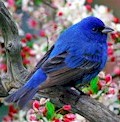There is a chill in the air. Winter is approaching. As the supply of insects declines, birds will be searching for other sources of food. How many birds will you see at your feeder? That depends on how well you set up your backyard or garden. In this article, I will review some very easy steps that anyone can take to be virtually assured of attracting a variety of wild birds.
First, consider the basic needs of wild birds. They are the same three needs that all animals and people share - food, water, and shelter. Let's take these issues one at a time.
FoodIf you throw a bunch of seeds or stale bread on your lawn, you will attract birds. (See, I told you it was easy!) Of course, you will also attract squirrels, raccoons, cats, possums, and a host of insects. The birds that come around may only be starlings, sparrows, and crows. If you are not selective about which birds you attract, and you don't mind having some other critters creeping around, then bird feeding could be that simple. This is not the method preferred by most backyard birders. To be more bird-selective, (and thereby reduce the number of unwanted prowlers), just be a little more selective about the type of food offered. Black oil sunflower seed and mixes of various seeds are available at many supermarkets or, usually more cost-effectively, at feed stores and garden centers. These foods attract a variety of wild birds, including chickadees, nuthatches, titmice, buntings, sparrows and cardinals. They can be placed in tube feeders or platform feeders, tube feeders being more selective toward the smaller songbird species.
Suet, which is raw beef or mutton fat, is a great, high-energy food for birds. Suet can be bought in preformed blocks at the supermarket, purchased unformed at the butcher shop, or formed by hand from the beef trimmings in your own kitchen. Suet, which is often mixed with nuts or seeds as an added bird-bonus, is particularly beneficial in the cold winter months when birds can really use the extra calorie boost.
Fruit, berries, and even peanut butter are also good for attracting wild birds. Whatever variety of food you choose, always keep the feeder clean to protect against bacteria that can harm the birds.
WaterEvery living thing on earth needs water. A proper birdbath will attract many birds, some of which are pure insectivores and do not use bird feeders. The water in a birdbath should be no more than three inches deep to attract the greatest variety of wild birds. It is best if the floor of the birdbath is fairly light in color, so the birds can clearly gauge the depth. The floor of the birdbath should also slope gently to the deepest part, and it should be textured to assist birds with footing. The birdbath itself could be on a pedestal, hung from a branch or pole, or, if there is no danger from cats, it may be placed directly on the ground. In the winter, it may be necessary to add warm water to keep it from freezing, as most birds are poor skaters.
atching the amusing antics around a birdbath is a uniquely entertaining experience for backyard birders. Birds of various species often perch around the rim, sporadically splashing, drinking, and preening in the water.
ShelterMany times, providing shelter for birds is an easy task. Place your feeder in a spot that is near some trees. Birds will fly into the trees when they seek protection from weather or predators. Make sure there are no shrubs or high grass (or any other place where a cat might lay in ambush) within 12 feet of the bird feeder. The birds will take it from there.
Over the years, we have encroached on wild birds' domain, polluted the air and water, and otherwise contributed to a shift in the natural balance that has put the survival of many bird species in question. We owe it to them to give a little assist. Recent conservation efforts have done much in that regard, but there is still a long way to go. Feed the birds and take another step to a happier, healthier world.
